
BY SCOTT STIFFLER | Having made its May 2020 debut as outdoor space repurposed to alleviate the social distancing concerns of COVID-19, New York City’s Open Streets initiative introduced the notion of closing certain blocks to most vehicular traffic for up to 12 hours daily.
Eighteen months later, the program that temporarily transfers custody of the road from emission-spouting cars and trucks to mission-focused pedestrians, joggers, and dog walkers continues to inspire strong opinion from devotees and detractors alike. With outgoing Mayor Bill de Blasio receiving decidedly mixed reviews for his stewardship of the program he ushered in, Open Streets’ long-term success depends not on overcoming its barriers, but on retaining them.
That’s not a metaphor. Barriers—the interlocking metal variety used for crowd control along NYC parade routes—are essential for preventing cars from treating Open Streets like an open invitation to conduct business as usual. In fact, only “local traffic” is allowed (residents of the block, pick-ups/drop-offs, and emergency and delivery vehicles). Drivers of such vehicles may move the barricades enough to gain entry, at which point the social contract expects them to put things back to the way they were, and be on their way. Whether unintentionally (simple forgetfulness) or outright spite (“I pay taxes! I have a right to drive on this street!”), responsibility for returning the barricades to their rightful position repeatedly falls to the “community partners” whose volunteer efforts the Open Streets program has become dependent upon. Volunteers are especially vital for streets designated as Limited Local Access (W. 22nd is one of them). Such streets are able to move their barriers throughout the hours of operation, and can accommodate “local traffic.” Open Streets designated as Full Closure see their barriers remain closed during hours of operation. Such streets still rely on their community partners, however, leaving many Open Streets to wither on the vine when the volunteer workforce quits or performs their duties in proportion to the classic “You get what you pay for” quality control calculator.
Pedestrian and biking advocacy group Transportation Alternatives makes no bones about its goal to “reclaim New York City’s streets from the automobile.” Their October 12, 2021 report (Open Streets Forever: The Case for Permanent 24/7 Open Streets) called Open Streets “popular, beloved, effective, and lifesaving,” but said its many advantages “are lost when infrastructure is subpar.”
In an April 29, 2021 Bloomberg.com article (Can ‘Open Streets’ Outlast the Pandemic?) that heavily referenced material from Transportation Alternatives’ in-house report, article author John Surico observed there is “little city support for running this programming. The budget for administering Open Streets, which is overseen by the city’s Department of Transportation (DOT), will grow to $4 million next year, but this is largely for materials. Donations pay for some stipends to dance or teaching instructors, many of whom saw business dry up during the pandemic.” Anticipating a world that has mostly returned to its brick and mortar ways, Surico noted, “It’s hard to imagine that this kind of all-volunteer effort is sustainable, especially if remote work dissipates.”
True to form, Chelsea residents found a way to make the hard to imagine materialize. Locally, the block of West 22nd Street between Seventh and Eighth Aves. (entrance point on Eighth) was among the very first to participate in Open Streets. All it took, recalled West 22nd Limited Local Access Open Street founder/manager Melodie Bryant, was her signature on an application and her declaration that she was affiliated with a local group (a nearby block association).
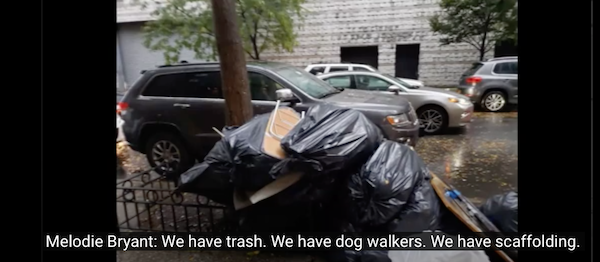
Fast forward almost six months from its April debut: Despite the ongoing challenge of daily barrier maintenance from 8am to 8pm, a growing alliance was determined to keep W. 22nd an Open Street in perpetuity. To that end, 30-year block resident Bryant found herself making a presentation at the November 18, 2020 meeting of the Transportation Planning Committee of Manhattan Community Board 4 (CB4). Because of W. 22nd’s narrow sidewalks, said Bryant, “People were already walking on the street and an Open Street, I thought, would make it safer.” Once established, word spread and soon “Families came from other blocks to teach their kids how to ride bikes.” At the time of the presentation, noted Bryant, the city’s messaging regarding Open Streets was subject to change. It had been set to expire, and its fate seemed tied to the city’s Open Restaurants program. A bill before the City Council (ultimately passed in 2021) would make Open Streets permanent and expand its reach throughout the five buroughs.
On December 2, at their monthly full board meeting, CB4’s collective membership aligned themselves with the findings of their Transportation Committee, voting 38 in favor, 0 opposed “to support the community request” for permanence. In a Dec. 8 letter to NYC Department of Transportation (DOT) Manhattan Borough Commissioner Ed Pinksy, CB4 Chair Lowell Kern (writing on behalf of CB4 in the language of the letter just approved by the full board) noted the W. 22nd “Open Street Program has been successful thanks to the commitment of the block association and the activist, Melodie Bryant, who partnered with the DOT. MCB4 received a large number of letters supporting this request and none opposed.” The letter also requested “that the DOT implement improvements to the program that will make it easier for this block and others to participate.” Suggestions included “Official DOT signage… to increase drivers’ compliance” and “lighter, more resilient barriers.” Such barriers, CB4 noted, “should be provided by DOT as it seems inappropriate to distract there NYPD from more critical tasks.”

Bryant recalled that during this and other moments of uncertainty when it “looked as if we might lose the program,” she felt that, “If we could not have an Open Street, we might at least try for other changes that would make life here more pleasant. What did people want?” To that end, she created a survey whose questions included how participants used their Open Street (walking, exercise, play, and parking were among the choices), and what sort of changes they’d like to see. Of the 154 respondents, “Ninety-one percent favored keeping 22nd Street as an Open Street, and seventy-four percent wanted more greenery,” said Bryant, who added that once it became clear that they could keep their Open Street, the notion of more nature and less metal merged with the ongoing debate about what to do with those omnipresent barriers. “The planters seemed the perfect answer for that,” recalled Bryant, as talk turned to four concrete planters filled with flora that arrived on Nov. 10, courtesy of the DOT in response to longstanding requests that the gatekeeping aspect of Open Streets be made easier on the back of volunteers, and the eyes of beholders. “DOT was also offering granite blocks” as an alternative, said Bryant. “They’re quite pretty, actually, but we ended up choosing the planters because they both set the tone for the street, and discourage speeding through it.”
This noticeable improvement did not escape the notice of CHEKPEDS (Clinton Hell’s Kitchen Chelsea Coalition for Pedestrian Safety). In a November 13 post to their website, “Team Chekpeds” (the byline for all of their activist-minded content presented in a traditional news format) called the replaced metal barriers “broken down and defensive” and praised the DOT’s “major upgrade to two Open Streets in Chelsea” (the second one being W. 21st St. btw. 9th & 10th Aves.). The addition of those large planters, noted CHEKPEDS, “is a terrific improvement that sends a strong message to drivers: ‘Slow Down.’ ”
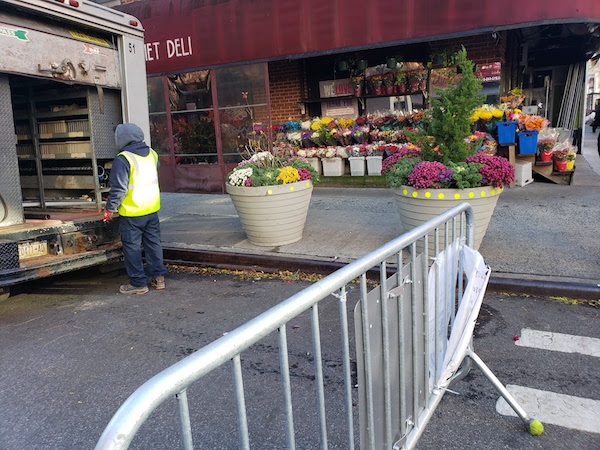
That strong message didn’t quite sink in for a few action-oriented individuals. On Nov. 20, Chelsea Community News received an email from Bryant, with two photos (placed above and below this paragraph). “It seems the traffic calming-measures that these planters provide do not agree with the agenda of some drivers who believe speeding through an Open Street is their right,” wrote Bryant. who noted the offending parties (“vigilantes” in her language) brought ramps to hasten placement of the four planters from the street to above the curb. Be that as it may, “DOT will be here on Monday to put them back where they belong,” said Bryant.
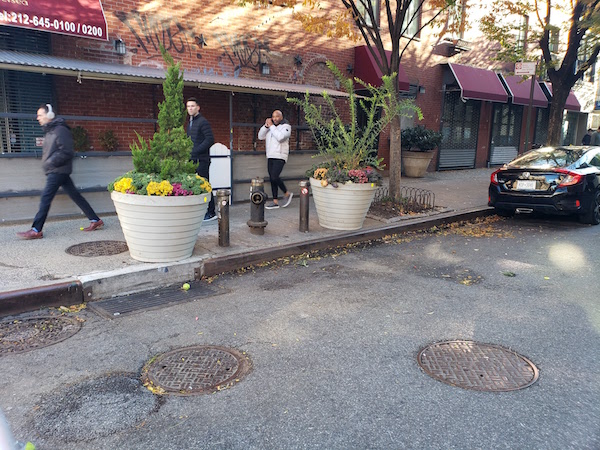
DOT’s Horticulture Division did indeed show up as scheduled, with their own brawn, and delivered the planters back to their original location. “Seems cameras will have to be installed here,” Bryant noted. “More to be revealed.”
Some cards in that hand were either played at CB4’s Dec. 1 full board meeting, which saw testimonial from several W. 22nd St. residents—including Bryant—who appeared as part of the meeting’s Public Session, in which any member of the public can sign up for two minutes of uninterrupted time, to speak to the board about a topic, or topics, of their choosing. Also, Agenda Item #11, was the most recent Open Streets-themed letter generated from the Transportation Planning Committee. Addressed to the DOT’s Commissioner Pincer, it lauded the effectiveness of the new planters and expressed CB4’s support for, well… read the below letter in full.
Speaking with Chelsea Community News on the afternoon of Saturday, December 4, CB4 Chair Lowell Kern noted the letter “passed unanimously,” although there were “minor changes,” including line 22 of the above draft version “It was suggested,” recalled Kern, “that the light not be permanent red and some turns would be permitted, signaled by a flashing red arrow.”
As for the addition of features including a Citi Bench and a bike corral, “The specific asks came from the residents of this block,” noted Kern. “They seem to love the Open Streets program and want to enhance it. So if that’s what they’re asking for, the board is going to support it.” Kern, for whom sending the letter’s final version to DOT will be one of his last actions before term limits compel him to step down as Chair, said it was especially rewarding to see W. 22nd St. free of the many vehicles that found their way there when seeking a less congested crosstown driving experience than what the narrow lanes of 23rd St. can offer.
Appearing before the full board of CB4 as part of their Dec. 1 meeting’s Public Session—and making full use of her two-minute time slot—West 22nd St. resident Caroline Wood spoke about the ripple effect Open Streets is having on her block. (To view her testimony, click here and fast-forward to the One Hour, Six Minutes, and Twenty Seconds point). Wood said, in part:
“I just wanted to bend your ear for under two minutes, to throw not only my support, but so many of my neighbor’s support, behind Melodie Bryant and all the work she’s done to make our block something we could not have imagined before. I first met Melodie only about a year ago, and she would talk to me about loading zones and permanent signage discouraging through traffic and benches and bike corrals and I would I would kind of nod, thinking, like, ‘That all sounds great.’ But I honestly did not have the imagination to understand how that would change our block. And now that we’ve lived with our Open Street, our lovely Open Street for almost I don’t know, I think it’s been a year, I can imagine it. . . so now I want to talk about it and I want to advocate for it. We’ve seen the difference that less car traffic makes on our block. And it’s superficial things like things being cleaner and friendlier. But things also feel safer. And by friendlier, I don’t just mean neighbors stopping to chat. I mean we have more neighborhood engagement. We care more. We talk to each other more. We’re more aware of what happens on our block, and it’s because we stop five, six times a day to move those gates [laughs] and we meet each other and we actually have a lot of positive interactions with people driving through. [Timekeeper says, “Ten seconds left.”] Thanks so much. That’s really it, just more and more support for our Open Street.”
–END–
Chelsea Community News is made possible with the help of our awesome advertisers, and the support of our readers. If you like what you see, please consider taking part in our GoFundMe campaign (click here). To make a direct donation, give feedback, or send a Letter to the Editor, email scott@chelseacommunitynews.com.
BONUS CONTENT: Links to other articles of interest, more W. 22nd St. photos
From City Limits, Nov. 17, 2021 | OPINION by Vanessa Gibson and Carolina Rivera: It’s Time for Permanent, Equitable 24/7 Open Streets
From Our Archives, Aug. 1, 2020 | Case Closed, Say Supporters: Open Streets Program Should Stay, Improve, Expand
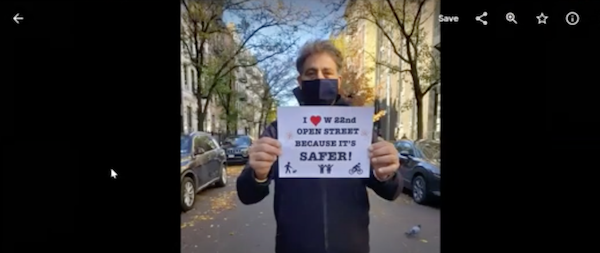
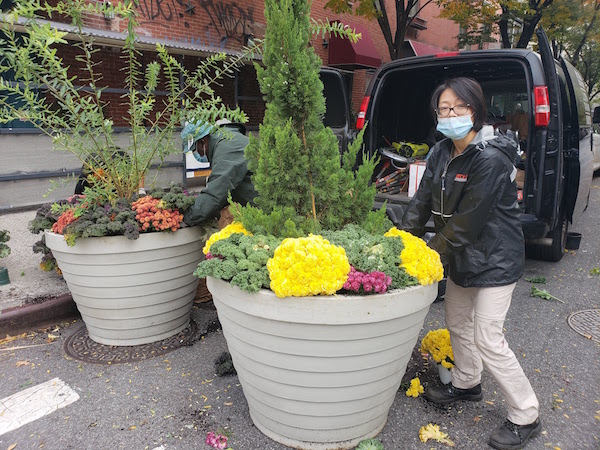
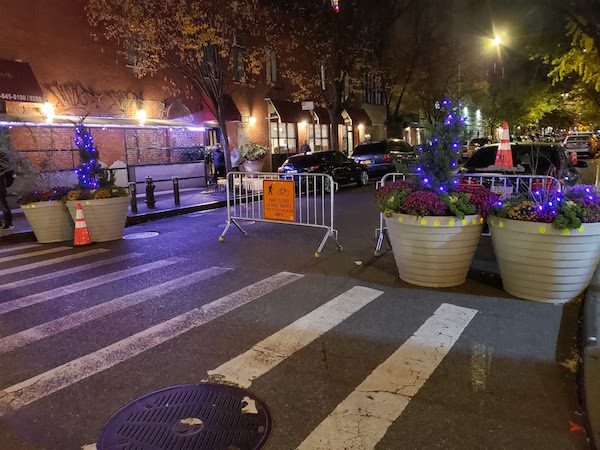

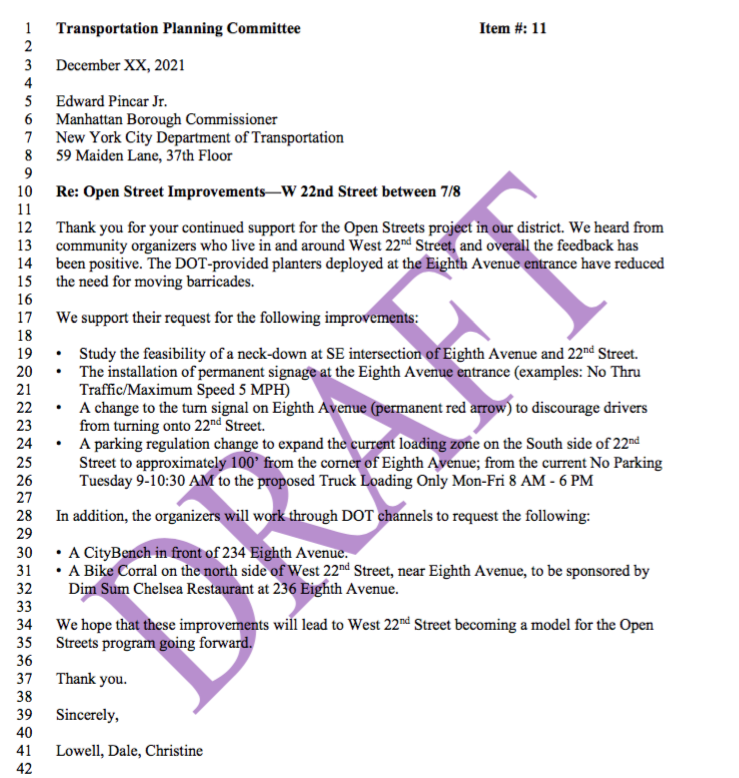
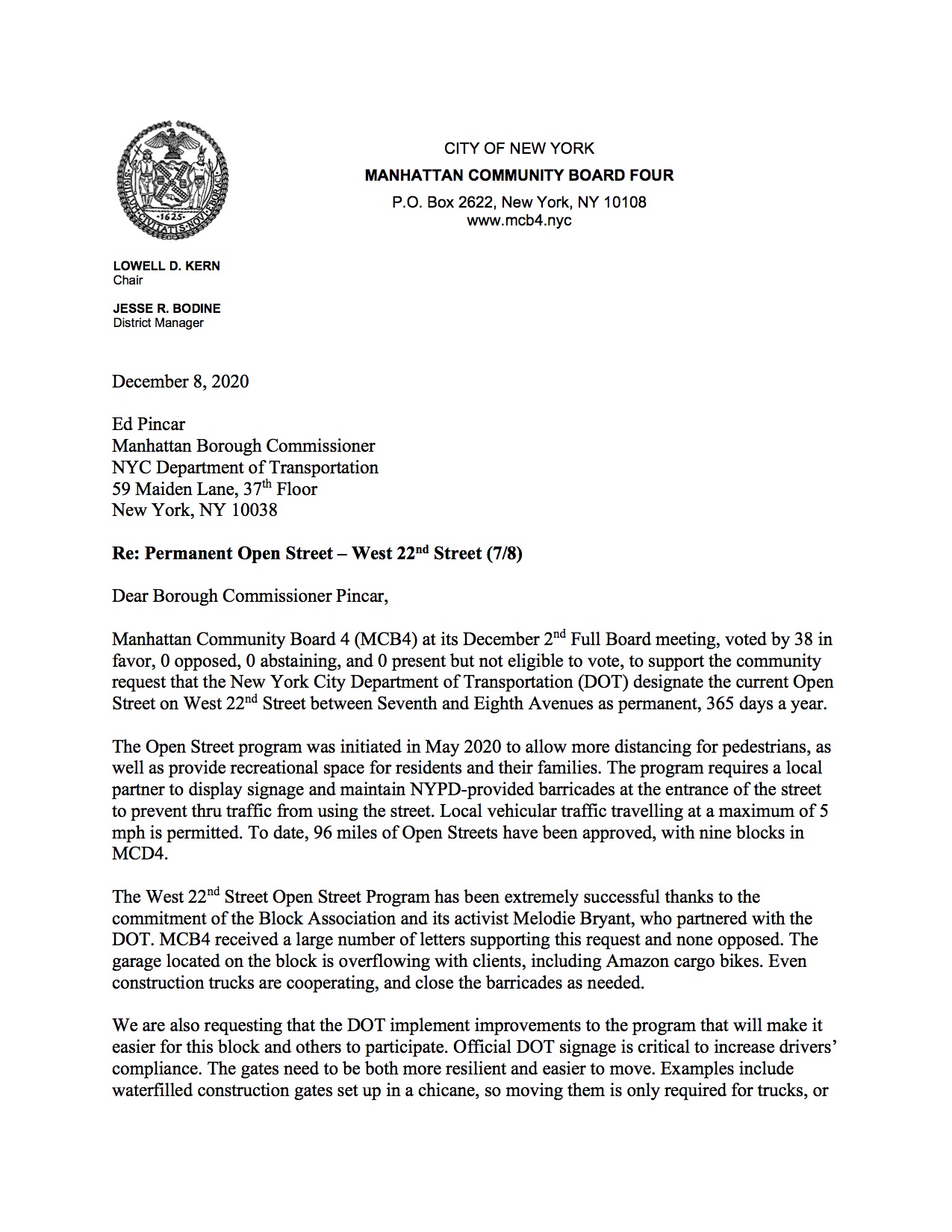
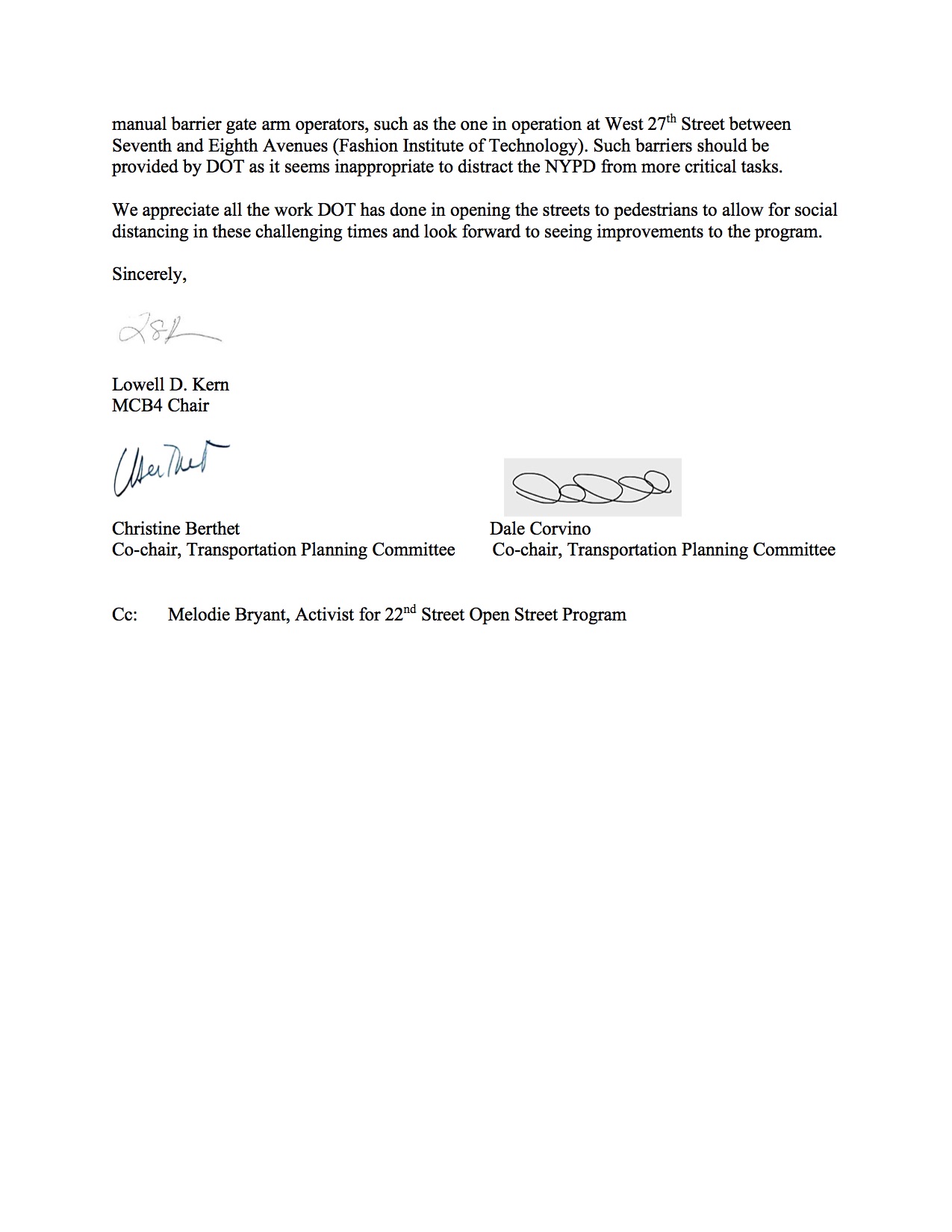
You must be logged in to post a comment Login